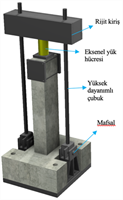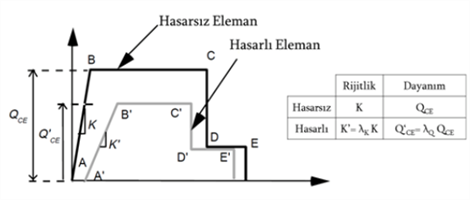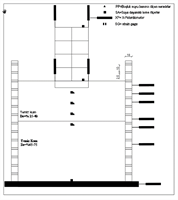In the first project, reinforced concrete column tests and building-scale structural analyzes will be carried out to determine the acceptable damage criteria for the "Repairable Damage" situation and to determine the earthquake performances after repairing structural members that are damaged at different levels. In the other project, the soil-structure interaction will be examined on liquefied soils, and its kinematic and inertial effects will be investigated.
You can find detailed explanations about the projects coordinated by Prof. Dr. Alper İlki and Assist. Prof. Dr. Esra Ece Bayat, respectively, below.


Project Title: A new performance target in earthquake resistant building design: “Repairable damage” and innovative repair methods for code complying structures
Project Type: TÜBİTAK 1001 – Deprem Özel Çağrısı
Project Coordinator: Prof. Dr. Alper İlki
Abstract:
Structures built in earthquake zones are designed and constructed in such a way that they can be damaged at certain levels under earthquakes, but will not collapse and cause loss of life. Therefore, after earthquakes, the buildings that are designed and built according to regulations can be damaged to a degree that cannot be technically or economicall repaired. For example, after New Zealand earthquakes:
1) Damage assessment processes took years and the economic activity center of the city remained unusable for a long time.
2) Since there is not enough information about post-repair earthquake performance of the code complying structures, almost all of the damaged structures, including light and medium damaged ones, were demolished and rebuilt.
After this experience, which caused tremendous economic losses and social problems, the concept of "Life Safety" design was opened to discussion.
While the increasing number of code complying buildings is beneficial for reducing casualties in the upcoming period, since these structures designed for "Life Safety" performance the uncertainties about the repair applications whether they can bring the structural performance back to an identical level of safety before the earthquake may cause demolition and reconstruction of these structures. To avoid this situation which will cause great economic losses and be an obstacle for returning to normal life, in this project; A new performance level, which can be considered in building design instead of "Life Safety" performance level will be developed. The new level is aimed to remain at a point between "Immediate Occupancy", which is not economically feasible for design, and "Life Safety" performance level which may cause major damage after earthquakes. This new earthquake design performance level, which will be calibrated to be economically and technically feasible, will be named as "Repairable Damage". This approach will reduce the number of situations requiring destruction and reconstruction of the damaged structures will enable our national wealth and natural resources to be used more efficiently.
Reinforced concrete column tests and building-scale structural analyzes will be carried out to determine the acceptable damage criteria for the "Repairable Damage" situation and to determine the earthquake performances after repairing structural members that are damaged at different levels. In the experimental studies, 24 full-scale reinforced concrete column samples with different properties will be tested under realistic conditions. With experimental test results, nonlinear behavior modification coefficients will be derived for damaged and repaired elements. Also, within the scope of the project, numerical models will be created for twenty different building systems. Earthquake behaviors of these models will be calculated for the undamaged conditions, earthquake-damaged and repaired situations. In the light of the numerical results, fragility models will be obtained and the performance criteria defined for the proposed new performance target will be verified with a probabilistic approach.


Project Title: Development of the design criteria for buildings in liquefiable soils with emphasize on foundation type and soil-structure interaction
Project Type: TÜBİTAK 1001-Deprem Özel Çağrısı
Project Coordinator: Assist. Prof. Dr. Esra Ece Bayat
Abstract:
In this project proposal, the soil-structure interaction will be examined on liquefied soils, and its kinematic and inertial effects will be investigated. Considering the kinematic effects in the liquefied soil, the accelerations and deformations that will reach the foundation will be obtained by parametric numerical analysis for different foundation types (mat foundation, continuous foundation, piled foundation) built at the surface and in cases where there is a certain foundation depth. These acceleration and deformation records will be solved for the inertia interaction of the superstructure, and the settlements and rotations that will occur in the building will be determined. All these analyses will also be modeled as a whole with the direct structure-soil interaction solution and the settlements and rotations in the building foundation will be compared with the results determined by the superposition method (kinematic + inertia). As a result of these numerical analyses, settlements and rotations due to liquefaction can be predicted with a soil-structure interaction methodology that can be determined by the superposition method. Perhaps, by estimating the spring constant and damping ratios for the liquefied soil, a methodology proposal may come up to estimate the displacement and rotations that will occur in the structure. Another purpose or output of this study is to comparatively determine the effect of foundation types and foundation depth (basement floor effect) on the settlement and rotation that will occur at the foundation of the building and to develop design criteria for foundation design in such soils or remediation procedures for existing foundations. In this project proposal, in the third work package, the water-saturated sand soil samples prepared in the newly designed laminar container will be tested with different foundation types and shake table experiments, which are examined in numerical analysis. The validity of numerical models will be examined by comparing the numerical analysis results with the physical test results. We believe that it will be a pioneering study in determining the fundamental behaviors of existing and new structures founded in, soils with such liquefaction potential according to the foundation type and soil-structure interaction, and in proposing the design and improvement criteria for these structures in our country, where a large part of it is an earthquake zone.